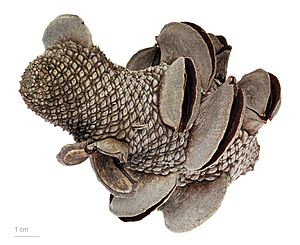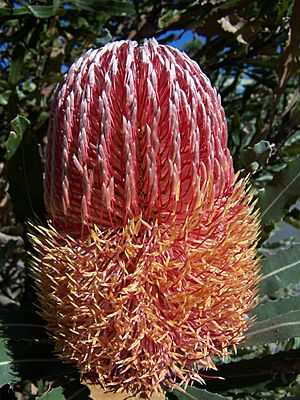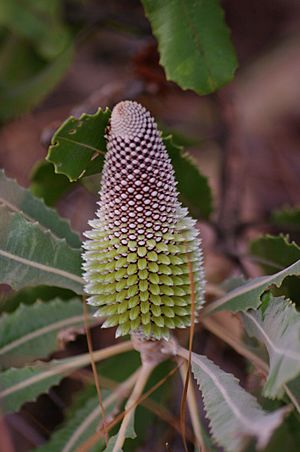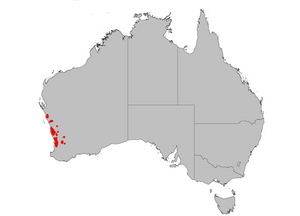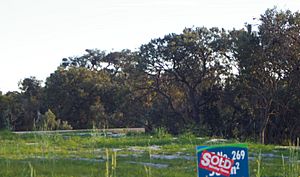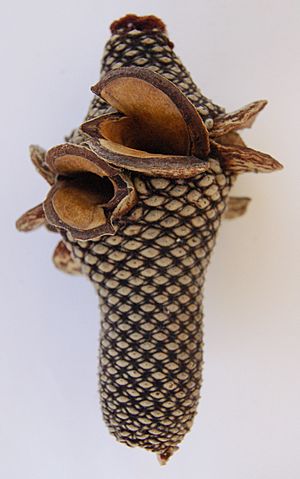Firewood banksia facts for kids
Quick facts for kids Firewood banksia |
|
|---|---|
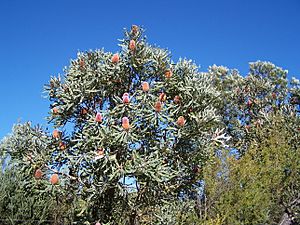 |
|
| Tree habit, Jandakot Botanical Gardens | |
| Scientific classification |
The Banksia menziesii, also known as firewood banksia, is a type of flowering plant. It belongs to the Banksia group. This plant can grow as a tall, twisted tree, up to 10 meters (33 feet) high. In drier, northern areas, it might be a lower, spreading shrub, about 1 to 3 meters (3 to 10 feet) tall.
Its leaves are a dull green with jagged edges. New leaves are a lighter grey-green. In autumn and winter, it produces striking flower spikes. These are often two-colored, like red or pink and yellow. This has given it other fun names like port wine banksia and strawberry banksia. Yellow flowers are quite rare to see.
A botanist named Robert Brown first described this plant in the early 1800s. There are no different types (varieties) of Banksia menziesii officially recognized. You can find it in Western Australia, from the Perth area up to the Murchison River. It usually grows in sandy soils, in scrubland or light woodland areas.
The firewood banksia is a food source for many different animals, from tiny bugs to birds. Honeyeater birds especially love to visit its flowers. This plant is quite tough and is often planted in gardens and parks in Australian cities. However, it doesn't do well in places with humid summers, like Sydney. This is because of a plant disease called dieback. Banksia menziesii is also popular in the cut flower industry in Australia and other countries.
Contents
What Does Firewood Banksia Look Like?
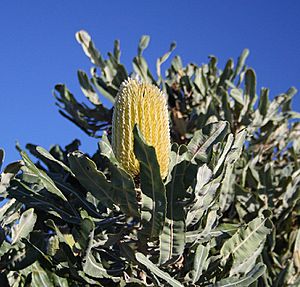
The Banksia menziesii can be a twisted tree up to 10 meters (33 feet) tall. Or, it can be a shorter, spreading shrub, about 1 to 3 meters (3 to 10 feet) high. You often see it as a shrub in its northern range, where the climate is warmer and drier. Shrub forms have many stems growing from a woody base called a lignotuber.
The tree's trunk is grey, sometimes with hints of brown or pink. Its rough bark, about 2 to 3 cm (0.8 to 1.2 inches) thick, peels off easily. New branches are covered in fine brownish hairs. These hairs disappear after a few years, leaving smooth stems and leaves. Branches that will grow flowers next year are usually thicker and longer.
The leaves are long and narrow, somewhat flat at the ends. They are grey-green, about 8 to 25 cm (3 to 10 inches) long and up to 4 cm (1.6 inches) wide. New leaves are lighter and slightly fuzzy. The edges of the leaves have many small, triangular teeth, about 1 to 2 mm long. The underside of the leaf has a central vein covered in fine, pale brown hairs.
Amazing Flower Spikes
This banksia flowers in autumn and winter, mostly from May to July. It takes about eight months for the flower spikes to fully grow. The flower spikes are oval to cylinder-shaped. They can be 7 to 8 cm (2.8 to 3.1 inches) wide and 4 to 12 cm (1.6 to 4.7 inches) tall. Each spike is made up of many tiny individual flowers. One study found an average of 1043 flowers per spike!
Banksia menziesii has more flower colors than any other Banksia species. You can find flower spikes in many shades of pink, as well as chocolate, bronze, yellow, white, and even greenish colors. They look especially cool up close. When the flowers are still mostly buds, they look like a red or pink and white striped candy cane. The flowers tend to be a deeper red after colder weather. The red and pink colors come from natural pigments called anthocyanins.
Seeds and How They Grow
After flowering, the old flowers usually fall off quickly. Up to 25 large, beaked seed pods, called follicles, can grow. These pods are dark brown and grey, often with cool patterns when they are new. They are oval-shaped, about 2.5 to 3.5 cm (1 to 1.4 inches) long.
Only a small number of flowers turn into seed pods. The plant needs fire to release its seeds. The pods only open after being burned. Each pod holds one or two wedge-shaped seeds, separated by a woody piece. The color of the seeds can tell you what color the flowers will be! Pale seeds grow into yellow flowers, dark grey seeds into red flowers, and black seeds into bronze flowers.
Young Banksia menziesii plants (seedlings) have small, rounded first leaves. The leaves that grow after these are crowded and very hairy, with jagged edges. Even at five months old, seedlings start to show signs of forming a lignotuber. This is the woody base that helps the plant regrow after a fire.
Naming the Firewood Banksia
The common name "firewood banksia" comes from how easily it burns. Other names include Menzies banksia, firewheel banksia, and flame banksia. In the cut flower business, it's sometimes called strawberry banksia or raspberry frost banksia. The local Noongar people of the Perth area call it Mungyt or Bulgalla.
Even though the plant looks a bit different across its range, scientists agree it's one clear species. There's no need to divide it into smaller groups.
A Bit of History
The first samples of Banksia menziesii were collected in 1827. This was done by botanist Charles Fraser during an exploration of the Swan River. The next year, some of these samples were sent to Robert Brown.
Brown officially named the species in 1830. He named it menziesii to honor Archibald Menzies. Menzies was a surgeon and naturalist who explored King George Sound in 1791. So, the full scientific name is Banksia menziesii R.Br. Interestingly, neither Brown nor Menzies ever saw the plant growing in its natural home.
Over the years, scientists have changed how they group Banksia species. In 1981, Alex George placed Banksia menziesii with its closest relatives. He thought Banksia speciosa and Banksia baxteri were its closest family. These two other banksias have yellow flowers and different leaf shapes.
Where Firewood Banksia Lives
Banksia menziesii mostly grows in the deep, sandy soils of the Swan Coastal Plain and Geraldton Sandplains. Its range stretches from Waroona in the south to Kalbarri in the north. However, it's not very common south of Mandurah.
It usually doesn't grow east of the Darling Scarp because of the heavy soils there. But you can find it in small sandy spots in the Jarrah Forest and Avon Wheatbelt areas. Sadly, much of its home on the Swan Coastal Plain is being lost. This is due to the growing city of Perth, which means land is cleared for houses.
This banksia is a very important part of the plant communities on the Swan Coastal Plain. It grows with Banksia attenuata (candlestick banksia) in many areas. These plants grow in deep, sandy soil that drains well. In areas with shallower, wetter soils, other Banksia species take their place. In the northern Geraldton Sandplains, Banksia menziesii often grows as a shrub or small tree above low heathland.
How Firewood Banksia Lives
Like many plants in its family, Banksia menziesii needs help from animals to make seeds. Its flowers release pollen that becomes inactive before the female parts are ready. This encourages cross-pollination with other plants.
Banksia menziesii is a key food source for the threatened short-billed black cockatoo. Many other birds also feed on it, including parrots and several types of honeyeaters. Insects like ants, bees, and beetles also visit the flowers.
This plant can regrow after a bushfire. It sprouts new growth from its woody base (lignotuber) or from buds on its trunk. In the southern parts of its range, it doesn't hold onto its seeds for long. The seed pods open after about two years, releasing seeds. But in the north, plants hold more seeds. Hotter fires in drier climates are more likely to kill the plants, which then releases the seeds. This helps new seedlings grow.
All banksias have special "proteoid" or "cluster" roots. These roots form a dense mat under the soil. They help the plant get nutrients from the poor Australian soils, especially phosphorus. Studies show that Banksia menziesii roots grow new parts after winter rains. The bacteria around its roots are also different from other banksia species.
Banksia menziesii can use water from the water table (underground water). This means it can grow in more places than some other banksias. However, the water table in the Perth area has dropped. This is due to water being used for the city and less rainfall. This has caused a decline in Banksia menziesii since the 1960s. The plant is also sensitive to salty water and sulfur dioxide pollution.
Growing Firewood Banksia
Banksia menziesii is a popular plant for gardens. It has pretty buds and seed pods, attractive new leaves, and showy flowers. You can often find a smaller, dwarf version in plant nurseries.
This plant is fairly easy to grow in a mediterranean climate with good drainage and sandy soil. However, it can be affected by dieback disease. This disease thrives in humid summers or poorly drained soil. Using special fungicides can help reduce the spread of the disease. It's also grown commercially in South Australia, California, and Hawaii for cut flowers.
You don't need to do anything special to the seeds before planting them. They usually sprout in 26 to 40 days. Remember, the color of the seed tells you the future flower color! Pale seeds grow into yellow-flowered plants. Dark grey seeds become red-flowered plants, and black seeds grow into bronze-flowered plants. It usually takes about five to seven years for a plant to flower from seed.
The plant likes sunny spots and sandy, well-drained soil. You can prune it heavily if needed, as new growth can come from its woody base.
Art and Culture
The Beeloo Whadjuk Noongar people used the sweet nectar from Banksia menziesii to make a drink. They would drink it at special "sweet water festivals."
Banksia menziesii was the main subject of a book by botanical artist Philippa Nikulinsky. Her book showed the flower spike's journey from bud to full flower and then to seed release. The famous wildflower artist Ellis Rowan also painted it. In the early 1990s, the British pottery company Wedgwood featured this banksia on a series of plates.
Images for kids
-
Yellow and white flower colour variant, in late bud in the Beeliar Regional Park
See also
 In Spanish: Banksia de leña para niños
In Spanish: Banksia de leña para niños


